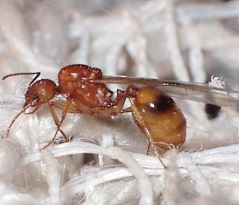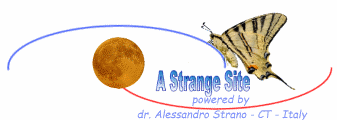Aphaenogaster splendida (Roger, 1859)
[IT] Dedico questa pagina alla memoria del mio carissimo amico e maestro Prof. Ezio Sgrò prematuramente scomparso nel febbraio 2008. La biografia di Ezio Sgrò è nel libro "Anna Maria Sgrò, Ezio: non si può cancellare un angelo, Laruffa Editore, Reggio Calabria, 2008".
[EN] I devote this page in memory of my dear friend and teacher Prof. Ezio Sgrò prematurely disappeared on February 2008. Ezio Sgrò's biography is in the book "Anna Maria Sgrò, Ezio: non si può cancellare un angelo, Laruffa Editore, Reggio Calabria, 2008".
[ES] Dedico esta página a la memoria de mi querido amigo y maestro Prof. Ezio Sgrò prematuramente difunto en el febrero 2008. La biografía de Ezio Sgrò es en el libro "Anna Maria Sgrò, Ezio: non si può cancellare un angelo, Laruffa Editore, Reggio Calabria, 2008".

Operaia e maschio / Worker and male / Obrera y macho
Catania 30/06/2004
foto / photo by / fotografía Alessandro Strano

Regina / Queen / Reina
Catania 07/07/2004
foto / photo by / fotografía Alessandro Strano

Sciamatura / Swarming / Enjambrazón
Catania 08/07/2007
foto / photo by / fotografía Alessandro Strano

La Coppia Reale (accoppiamento) / The Real Couple (mating) / La Pareja Real (acoplamiento)
Catania 14/07/2009
SUA MAESTA' LA REGINA (in English, en Español)
Aphaenogaster splendida (Roger, 1859) (classe Insecta, ord. Hymenoptera, fam. Formicidae)
Ogni anno a Catania (1) tra l'inizio di giugno e la metà di luglio nei nidi dell'Aphaenogaster splendida si assiste ad un frenetico movimento: è il tempo del volo nuziale e della sciamatura. Centinaia di esemplari tra maschi ed operaie paiono rincorrersi freneticamente nei pressi dell'ingresso del nido apparentemente senza un ordine preciso ma, invero, seguendo l'istinto che li condurrà alla fondazione delle nuove colonie.
Tre sono le caste sociali: operaie, maschi e regine (foto).
Le operaie, la cui lunghezza si aggira sui 5 mm, hanno un capo allungato di forma sub-ovale, due occhi composti tondeggianti, antenne di dodici segmenti con un lungo scapo, due vistose spine sul propodeo, lunghe zampe ed il peziolo con due nodini, caratteristica questa tipica della sottofamiglia Myrmicinae cui l'Aphaenogaster splendida difatti appartiene. Sono le operaie a svolgere tutti i compiti, dalla ricerca e raccolta del cibo sino alla manutenzione e difesa del nido.
I maschi, più piccoli delle prime, differiscono notevolmente dalle operaie. Il capo ha una forma sub-triangolare, ai lati vi sono due grossi occhi composti di forma ovale e sulla sua sommità trovano allocazione tre ocelli disposti a triangolo. Il torace ha un'inconfondibile conformazione che richiama alla mente la figura di una pipa e da esso si dipartono due paia di ali; le antenne hanno tredici segmenti e lo scapo è corto. I maschi muoiono poco dopo il volo nuziale.
Con un pizzico di fortuna si potranno osservare anche le regine. Sua maestà è un vero gigante in confronto alle altre caste, e proprio per la sua mole, quasi il doppio delle operaie, non può essere assolutamente confusa. La morfologia è simile a quella delle operaie; ha però un torace più robusto, due paia di ali che perderà dopo il volo nuziale e sul capo vi sono tre ocelli disposti a triangolo. Le regine sono le uniche femmine fertili, fecondate durante il volo nuziale, nel corso della loro vita deporranno migliaia e migliaia di uova dalle quali nasceranno gli individui che animeranno la vita sociale del nido.
ITS MAJESTY, THE QUEEN (in Italiano, en Español)
Aphaenogaster splendida (Roger, 1859) (class Insecta, order Hymenoptera, family Formicidae)
Every year in Catania (1) between the beginning of June and the middle of July, we can see a frenetic movement in Aphaenogaster splendida nests: it is the time for the nuptial flight and the swarming. Hundreds and hundreds of ants seem to run frenetically near nest entries apparently without any order but really they follow the instinct which will drive them to the foundation of new colonies.
There are three social castes: workers, males and queens (photos).
Workers, about 5 mm long, have an elongate head with a sub-oval shape, two rounded compound eyes, antennae with twelve segment of which the first one, the scape, is very long, two well developed spines on the propodeum, long legs and two nodes in the petiole, the last one is a typical characteristic of the subfamily Myrmicinae to which this species belongs. Workers make all tasks, from food research to the nest maintenance and defence.
Males, smaller than workers, have a very singular shape. Head has a sub-triangular shape, at its sides there are two oval big compound eyes and in the top there are three ocelli located as the vertices of a triangle. Thorax has an unmistakable shape resembling roughly a pipe; two pairs of wings are inserted in the thorax sides, antennae have thirteen segments and the scape is short. Males die after the nuptial flight.
With a great piece of luck we can see queens too. Its majesty, the queen is really a giant in comparison with other castes, it is about twice times bigger than a worker. Its morphology is similar to the worker one but it has a harder thorax with two pairs of wings, that however will lose after swarming, and three ocelli in the top of the head located as the vertices of a triangle. Queens are the only fertile females, fecundated only one time during the nuptial flight, in their life will lay thousands of eggs from which will be born the ants animating the social life in the nest.
SU MAJESTAD LA REINA (in Italiano, in English)
Aphaenogaster splendida (Roger, 1859) (clase Insecta, orden Hymenoptera, familia Formicidae)
Cada año en Catania (1) entre el principio de junio y la mitad de julio en los nidos de Aphaenogaster splendida hay un frenético movimiento: está el tiempo del vuelo nupcial y de la enjambrazón. Centenares de machos y obreras parecen alcanzarse frenéticamente aparentement sin algun orden mas, en verdard, son guiados por el instinto que lleverá a la fundación de nuevas colonias.
Hay tres castas sociales: obreras, machos y reinas (fotografiás).
Las obreras, largas cerca de 5 mm, tienen una cabeza alargada de forma sub-oval, dos ojos compuestos redundos, antenas con doce segmentos y un largo escapo, dos largas espinas en el propodeo, largas patas y dos nudos en el pecíolo, esta característica es típica de la subfamilia Myrmicinae a la cual esta especie pertenece. Son las obreras que hacen todos los trabajos, desde la busca del cibo a la manutención y defensa del nido.
Los machos, más pequeños, son mucho diversos de las obreras. La cabeza es de forma sub-triangular, en los lados hay dos gruesos ojos compuestos de forma oval y en la cima tres ocelas dispuestas a triángulo. El tórax tiene una característica forma que semeja a una pipa y dos pares de alas; las antenas tinen trece segmentos y el escapo es corto. Los machos muoren duespués el vuelo nupcial.
Con una pizca de fortuna, podemos ver también las reinas. Su majestad es realmente un gingante en paragón de las otras castas. Su morfología es semejante a aquélla de las obreras; mas tiene un tórax más robusto, dos pares de alas que perderá duespués el vuelo nupcial y en la cima tres ocelas dispuestas a triángulo. Las reinas son las únicas hembras fecundas, fecundadas durante el vuelo nupcial, en el curso de sus vida deponerán millares de huevos de los cuales nacerán las hormigas que animerán la vida del nido.
_____
(1)
[IT] L'Aphaenogaster splendida è presente solo in alcune aree del mediterraneo.
[EN] This species lives only in a few Mediterranean areas.
[ES] Esta especie vive solamente en pocas zonas del mediterráneo.
Un sentito ringraziamento è rivolto a / A special thanks you is to / Quiero agradecer
Ezio Sgrò per l'identificazione della specie / for this ant species identification / por la identificación de esta especie.
[IT] La foto della regina è stata pubblicata a p. 13 del n. 46 della rivista Quark (novembre 2004).
[EN] The photo at queen was published at page 13 of Quark no. 46 (November 2004).
[ES] La fotografía de la reina fue publicada a la página 13 del numero 46 del periódico Quark (noviembre 2004).
